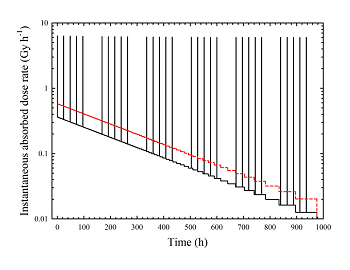
 | ||||||
| Radiation Delivery |
Definition: A radiation exposure scenario is a collection of one or more sequential time intervals in which the instantaneous absorbed dose rate is a constant (average) value greater than or equal to zero. The sample input file section of the User Guide shows how to setup exposure scenarios in the VC system of computer codes. | |
The Virtual Cell (VC) has been designed so that the biological responses to ionizing radiation can be estimated for arbitrary time-varying radiation levels. In the VC, the properties of a time varying radiation field are characterized by the instantaneous absorbed dose rate (Gy/h) as a function of time. This instantaneous dose rate function is termed an exposure scenario. Figure 1 to the right shows an example of an exposure scenario that might arise when an an external beam radiation treatment (EBRT) is combined with a brachytherapy treatment (BT). Many other types of exposure scenarios are encountered in laboratory experiments, radiation therapy, and certain workplace and environmental settings. | Figure 1. Combined Brachytherapy and External Beam Radiation Treatment (click on figure for additional details)  |
Tip: When the intensity of a radiation field varies over time in a complicated way (Figure 1), neither the instantaneous dose rate at some time point nor the average dose rate is appropriate for the prediction of biological effects. In cases such as these, a full description of the time varying radiation field is needed to accurately predict biological effects. The Virtual Cell is one of the few biological modeling tools available to predict the effects of temporally complex radiation fields. In laboratory experiments, two types of exposure scenario are often used: Examples of exposure scenarios that may be encountered in radiation therapy include
| |
| School of Health Sciences Purdue University Disclaimer | Last updated: 10 June, 2011 |